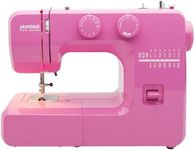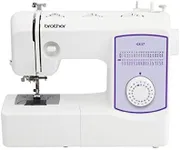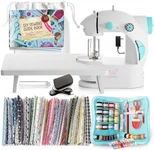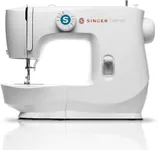Buying Guide for the Best Beginner Sewing Machines
Choosing a beginner sewing machine can feel overwhelming, but focusing on your needs and understanding the key features will help you make a smart choice. As a beginner, you want a machine that is easy to use, reliable, and versatile enough to handle basic projects. Think about what you plan to sew most often—simple repairs, clothes, crafts, or home décor—and let that guide your decision. Remember, the best sewing machine for you is one that matches your current skill level and can grow with you as you learn.Stitch OptionsStitch options refer to the different types of stitches a sewing machine can make, such as straight, zigzag, and decorative stitches. This is important because more stitch options give you greater flexibility for different projects. For beginners, a machine with a handful of essential stitches (like straight, zigzag, and a few decorative ones) is usually enough. Machines with too many stitches can be confusing at first, so start with a basic range and consider your future needs as you gain experience.
Ease of UseEase of use covers features that make the machine simple to operate, such as clear threading guides, automatic needle threaders, and easy-to-understand controls. This is crucial for beginners because it reduces frustration and helps you learn faster. Look for machines with intuitive layouts and helpful features like drop-in bobbins or quick-set bobbins. If you’re new to sewing, prioritize machines that are known for being user-friendly and have clear instructions.
Speed ControlSpeed control allows you to adjust how fast the machine sews. This is important because beginners often need to sew slowly to maintain control and accuracy. Some machines have a foot pedal that controls speed, while others offer a speed slider or button. If you’re just starting out, a machine with adjustable speed settings can help you build confidence and avoid mistakes.
Automatic FeaturesAutomatic features include things like automatic buttonhole makers, needle threaders, and thread cutters. These features save time and make sewing less intimidating for beginners. While not essential, they can make your learning experience smoother. If you want to focus on sewing rather than fiddling with setup, look for a machine with a few helpful automatic features.
Weight and PortabilityWeight and portability refer to how heavy and easy to move the sewing machine is. This matters if you need to store your machine between uses or take it to classes. Lightweight machines are easier to carry but may be less stable during use, while heavier machines are sturdier but harder to move. Think about where you’ll use your machine most and whether you need to transport it often.
Build Quality and DurabilityBuild quality and durability describe how well the machine is made and how long it’s likely to last. A sturdy machine will handle regular use and occasional mistakes better than a flimsy one. For beginners, it’s wise to choose a machine with a solid reputation for reliability, even if it’s a bit simpler. This way, you can focus on learning without worrying about frequent breakdowns.















